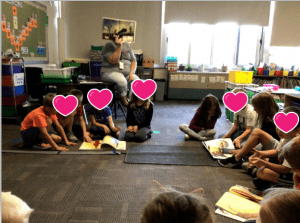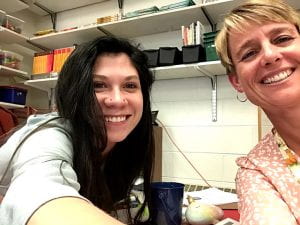
The purpose of scaffolding on a construction site is to support people in getting to places that are out of their reach. Without scaffolding, the job of a construction worker would be nearly impossible. Scaffolding provides the “just right” amount of support needed. It can be added to, and taken away.
Supports in the Kitchen
When learning something new, we often need strong support at the beginning of the learning experience. When first learning to cook, I needed guidance from a parent or adult who showed me how to follow a recipe, how to measure ingredients, how to use cooking tools, how to use a stovetop and an oven. Eventually, I reached a point where I was able to follow a recipe on my own. I can now make many dishes that once required me to follow a recipe step by step, but now don’t even require a peek at the recipe. I am able to cook many dishes without support, yet there are many that I still need that recipe to refer to from time to time, and there are new recipes that I need to follow step by step, with no deviation from the words on the page. Such was the case with the ribs that are marinating on my countertop, waiting to hit the smoker for the rest of the day. New recipe = a bit of stress while I followed every step of the recipe, carefully measuring each marinade ingredient.
Running Supports
As I slipped on my knee braces yesterday before a run, I thought about the days when I didn’t need those braces. I used to throw my running gear on and out the door I went. Over time, as the miles resulted in some significant wear and tear on my knees, I recognized that I needed to put some scaffolds in place in order to be able to keep running. My right knee was the squeakiest wheel, so I started wearing a brace on it about a year and a half ago. It wasn’t long before that left knee started to cry for help, so a second brace was added. My frustration with needing those braces is outweighed by the pleasure I get from running, so the braces win. We may not always want scaffolds and supports, but they are often necessary to achieve a desired result.

In the Classroom
Teachers have a perpetual delicate balance to strike: providing the “just right” amount of pressure and support for our students. Our job is to guide students to meeting proficiency on grade level standards. We provide scaffolds and supports in the name of giving all kids access to grade level curriculum. Sue Pimentel describes this work beautifully in Season 4, Episode 5 of Amplify’s Science of Reading the Podcast.
We want to push our students to work hard and experience the thrill of mastering a skill, while at the same time not pushing them so much that we frustrate them to the point of shutdown. Teachers are always, always wanting to help students – it’s what we do. We just have to be careful to not over or under-scaffold. This is a delicate balance to strike, indeed; it’s tough to find that sweet spot.
In the ELA Classroom
My heart clearly lies in English Language Arts instruction. It is here that teachers of ELA have a daunting job: ensuring proficiency in reading, writing, and speaking & listening standards. In all grades, kindergarten through twelfth, first grade takes the cake, with a whopping 72 ELA standards – 72!!! No pressure, 1st grade teachers.

Thank goodness we know that supporting students in demonstrating proficiency on 72 standards, in first grade, in ELA alone (not counting math, science, social studies, etc.) is not humanly possible. We unpack those standards until we find the standards that will give us the biggest bang for our buck, with guidance from resources like Achieve the Core and high quality curriculums that place heavier emphasis on those high leverage standards.
It was in a first grade classroom that I offered some coaching support this past week. Deb reached out for guidance with helping her students through a sequence of writing lessons in Module 1 of the EL Education curriculum. I suggested that she provide a scaffold in the form of sentence frames for all, or some, of her students, depending on how many she felt would need support (have I mentioned that finding the “just right” amount of support is a delicate balance to strike?).
After spending two different class periods with Deb and her students, and being blown away by what those first graders were doing… using words like “perseverance”, “initiative”, and “collaboration,” as part of EL’s focus on Habits of Character… Deb was on her own to finish the writing assignment with her students. Students were provided with the introduction sentence and the closing sentence; their task was to write the middle part: a sentence describing an event from the story, while referring to evidence from the story. In an email following the lesson, Deb relayed to me that the writing portion of the lesson was a flop. Students copied the opening and closing sentences and the sentence frame for the sentence that they were supposed to complete on their own, but didn’t actually write the rest of the sentence. Oops! Was it too much support? Not enough?

Deb reading to her 1st grade students, while they find evidence from the text
This is something that Deb, as the first grade teacher, will continue to work through, knowing that it will be ugly. First graders are learning to be readers and writers – there is MUCH struggle that comes with this. One of the best descriptions of this oh-so-important struggle at the first grade level can be found in Season 2 Episode 5 of Amplify’s Science of Reading the Podcast, with Margaret Goldberg and Alanna Mednick of the Right to Read Project.
Coaching Supports
In between visits to Deb’s classroom, I’ve been able to spend time in Chelsea’s kindergarten classroom. Chelsea is a brand new teacher in the Fort Madison Community School District, and is a teacher that we want to hold on to! She is energetic, anxious to learn right alongside her students, recognizes the power of collaboration, and actively seeks out support. She lacks confidence in herself, but she is wise enough to reach out for help and heed the advice she receives. Chelsea loves her kindergarten students: it is so evident in her interactions with them! She and I have launched a coaching cycle, where we will focus on the standards-based goal: “Students will know the names and sounds of upper and lowercase letters.”
While we work at supporting students in meeting that grade level goal, Chelsea has asked for support in classroom management. As a coach, it is my job to find the “just right” amount of scaffolding and support for Chelsea in this area. This will be achieved through modeling of lessons, co-teaching, and observation with reflection. I’m sure that I will have coaching missteps along the way, but know that those missteps are part of the important work that we do (coaches, teachers, students…!).
You see, as an instructional coach, I am just as nervous in wanting to do things right as Chelsea is in wanting to do things right as a teacher. I’m nervous about striking that perfect balance between pressure and support, so that Chelsea is able to deliver instruction successfully while having a strong handle on classroom management. I’m confident that we will be able to add and remove the right amount of scaffolding and support, so that our students can get to those places that are currently out of their reach. We’ve got this, Chelsea!

Chelsea and Megan upon the official launch of our coaching cycle!
Another great piece, Megan!